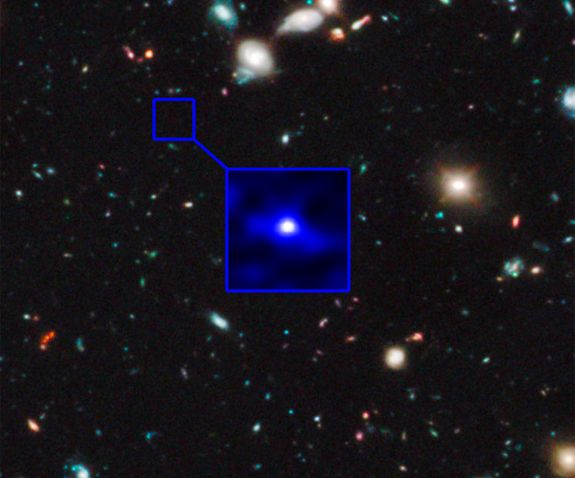
It took quite a bit more than seven days to create the universe as we know it today. Over eight weekdays, SPACE.com looks at the mysteries of the heavens in our series: The History & Future of the Cosmos. This is Part 5 in that series.
Our universe was born about 13.7 billion years ago in a massive expansion that blew space up like a gigantic balloon.
That, in a nutshell, is the Big Bang theory, which virtually all cosmologists and theoretical physicists endorse. The evidence supporting the idea is extensive and convincing. We know, for example, that the universe is still expanding even now, at an ever-accelerating rate.
Scientists have also discovered a predicted thermal imprint of the Big Bang, the universe-pervading cosmic microwave background radiation. And we don't see any objects obviously older than 13.7 billion years, suggesting that our universe came into being around that time.
"All of these things put the Big Bang on an extremely solid foundation," said astrophysicist Alex Filippenko of the University of California, Berkeley. "The Big Bang is an enormously successful theory."
So what does this theory teach us? What really happened at the birth of our universe, and how did it take the shape we observe today? [Infographic Tour: History & Structure of the Universe]
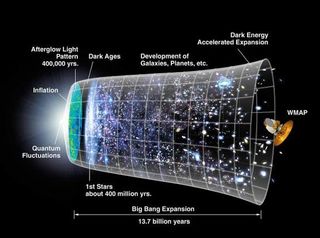
The beginning
Sign up for the Live Science daily newsletter now
Get the world’s most fascinating discoveries delivered straight to your inbox.
Traditional Big Bang theory posits that our universe began with a singularity — a point of infinite density and temperature whose nature is difficult for our minds to grasp. However, this may not accurately reflect reality, researchers say, because the singularity idea is based on Einstein's theory of general relativity.
"The problem is, there's no reason whatsoever to believe general relativity in that regime," said Sean Carroll, a theoretical physicist at Caltech. "It's going to be wrong, because it doesn't take into account quantum mechanics. And quantum mechanics is certainly going to be important once you get to that place in the history of the universe."
So the very beginning of the universe remains pretty murky. Scientists think they can pick the story up at about 10 to the minus 36 seconds — one trillionth of a trillionth of a trillionth of a second — after the Big Bang.
At that point, they believe, the universe underwent an extremely brief and dramatic period of inflation, expanding faster than the speed of light. It doubled in size perhaps 100 times or more, all within the span of a few tiny fractions of a second. [The Big Bang to Now in 10 Easy Steps]
(Inflation may seem to violate the theory of special relativity, but that's not the case, scientists say. Special relativity holds that no information or matter can be carried between two points in space faster than the speed of light. But inflation was an expansion of space itself.)
"Inflation was the 'bang' of the Big Bang," Filippenko told SPACE.com "Before inflation, there was just a little bit of stuff, quite possibly, expanding just a little bit. We needed something like inflation to make the universe big."
This rapidly expanding universe was pretty much empty of matter, but it harbored huge amounts of dark energy, the theory goes. Dark energy is the mysterious force that scientists think is driving the universe's current accelerating expansion.
During inflation, dark energy made the universe smooth out and accelerate. But it didn't stick around for long.
"It was just temporary dark energy," Carroll told SPACE.com. "It converted into ordinary matter and radiation through a process called reheating. The universe went from being cold during inflation to being hot again when all the dark energy went away."
Scientists don't know what might have spurred inflation. That remains one of the key questions in Big Bang cosmology, Filippenko said.
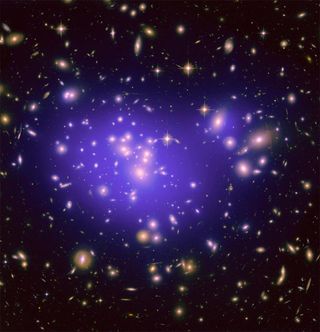
Another idea
Most cosmologists regard inflation as the leading theory for explaining the universe's characteristics — specifically, why it's relatively flat and homogeneous, with roughly the same amount of stuff spread out equally in all directions.
Various lines of evidence point toward inflation being a reality, said theoretical physicist Andy Albrecht of the University of California, Davis. [Images: Peering Back to the Big Bang]
"They all hang together pretty nicely with the inflationary picture," said Albrecht, one of the architects of inflation theory. "Inflation has done incredibly well."
However, inflation is not the only idea out there that tries to explain the universe's structure. Theorists have come up with another one, called the cyclic model, which is based on an earlier concept called the ekpyrotic universe.
This idea holds that our universe didn't emerge from a single point, or anything like it. Rather, it "bounced" into expansion — at a much more sedate pace than the inflation theory predicts — from a pre-existing universe that had been contracting. If this theory is correct, our universe has likely undergone an endless succession of "bangs" and "crunches."
"The beginning of our universe would have been nice and finite," said Burt Ovrut of the University of Pennsylvania, one of the originators of ekpyrotic theory.
The cyclic model posits that our universe consists of 11 dimensions, only four of which we can observe (three of space and one of time). Our four-dimensional part of the universe is called a brane (short for membrane).
There could be other branes lurking out there in 11-dimensional space, the idea goes. A collision between two branes could have jolted the universe from contraction to expansion, spurring the Big Bang we see evidence of today.
Looking for gravitational waves
Soon, scientists may know for sure which theory — inflation or the cyclic model — is a better representation of reality.
For example, inflation likely would produce much stronger gravitational waves than an ekpyrotic "bounce," Filippenko said. So researchers are looking for any signs of these theoretical distortions of space time, which have yet to be observed.
The European Space Agency's Planck satellite, which launched in 2009, may find the elusive gravitational waves. It may also gather other evidence that could tip the scales either way, Ovrut said.
"These are things that, within the next 10 years, will be discussed and hopefully decided," Ovrut told SPACE.com.
The universe we know takes shape
Cosmologists suspect that the four forces that rule the universe — gravity, electromagnetism and the weak and strong nuclear forces — were unified into a single force at the universe's birth, squashed together because of the extreme temperatures and densities involved.
But things changed as the universe expanded and cooled. Around the time of inflation, the strong force likely separated out. And by about 10 trillionths of a second after the Big Bang, the electromagnetic and weak forces became distinct, too.
Just after inflation, the universe was likely filled with a hot, dense plasma. But by around 1 microsecond (10 to the minus 6 seconds) or so, it had cooled enough to allow the first protons and neutrons to form, researchers think.
In the first three minutes after the Big Bang, these protons and neutrons began fusing together, forming deuterium (also known as heavy hydrogen). Deuterium atoms then joined up with each other, forming helium-4.
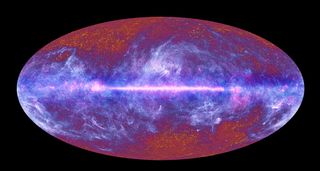
Recombination: The universe becomes transparent
These newly created atoms were all positively charged, as the universe was still too hot to favor the capture of electrons.
But that changed about 380,000 years after the Big Bang. In an epoch known as recombination, hydrogen and helium ions began snagging electrons, forming electrically neutral atoms. Light scatters significantly off free electrons and protons, but much less so off neutral atoms. So photons were now much more free to cruise through the universe.
Recombination dramatically changed the look of the universe; it had been an opaque fog, and now it became transparent. The cosmic microwave background radiation we observe today dates from this era. [Video: Fog of Early Universe Seen]
But still, the universe was pretty dark for a long time after recombination, only truly lighting up when the first stars began shining about 300 million years after the Big Bang. They helped undo much of what recombination had accomplished. These early stars — and perhaps some other mystery sources — threw off enough radiation to split most of the universe's hydrogen back into its constituent protons and electrons.
This process, known as reionization, seems to have run its course by around 1 billion years ago. The universe is not opaque today, as it was before recombination, because it has expanded so much. The universe's matter is very dilute, and photon scattering interactions are thus relatively rare, scientists say.
Over time, stars gravitated together to form galaxies, leading to more and more large-scale structure in the universe. Planets coalesced around some newly forming stars, including our own sun. And 3.8 billion years ago, life took root on Earth.
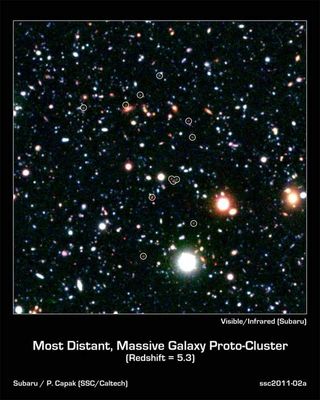
Before the Big Bang?
While much about the universe's first few moments remains speculative, the question of what preceded the Big Bang is even more mysterious and hard to tackle.
For starters, the question itself may be nonsensical. If the universe came from nothing, as some theorists believe, the Big Bang marks the instant when time itself began. In that case, there would be no such thing as "before," Carroll said.
But some conceptions of the universe's birth can propose possible answers. The cyclic model, for example, suggests that a contracting universe preceded our expanding one. Carroll, as well, can imagine something existing before the Big Bang.
"It could just be empty space that existed before our Big Bang happened, then some quantum fluctuation gave birth to a universe like ours," he said. "You can imagine a little bubble of space pinching off through a fluctuation and being filled with just a little tiny dollop of energy, which can then grow into the universe that we see through inflation." [Gallery: History & Structure of the Universe]
Filippenko also suspects something along those lines might be true.
"I think time in our universe started with the Big Bang, but I think we were a fluctuation from a predecessor, a mother universe," Filippenko said.
Will we ever know?
Cosmologists and physicists are working hard to refine their theories and bring the universe's earliest moments into sharper and sharper focus. But will they ever truly know what happened at the Big Bang?
It's a daunting challenge, especially since researchers are working at a 13.7-billion-year remove. But don't count science out, Carroll said. After all, 100 years ago, people understood very little about the universe. We didn't know about general relativity, for example, or quantum mechanics. We didn't know the universe was expanding, and we didn't know about the Big Bang.
"We know all these things now," Carroll said. "The pace of progress is actually astonishingly fast, so I would never give in to pessimism. There's no reason in the recent history of cosmology and physics to be pessimistic about our prospects for understanding the Big Bang."
Albrecht voiced similar optimism, saying we may one day even figure out what, if anything, existed before the Big Bang.
"I base my hope on the fact that cosmology has been so successful," he told SPACE.com. "It seems nature has sent us a clear message that we really can do science with the universe."
This story was provided by SPACE.com, sister site to LiveScience. You can follow SPACE.com senior writer Mike Wall on Twitter: @michaeldwall. Follow SPACE.com for the latest in space science and exploration news on Twitter @Spacedotcom and on Facebook.














